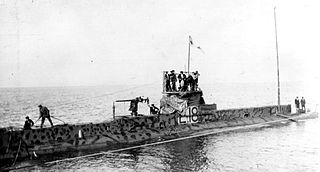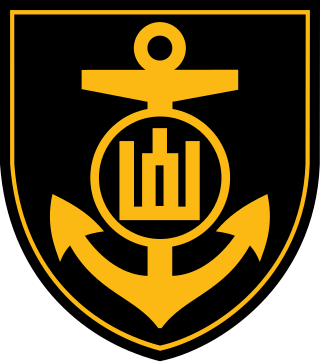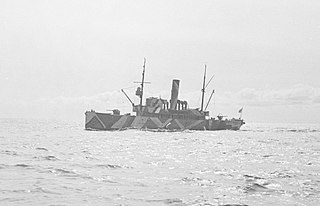
A naval mine is a self-contained explosive weapon placed in water to damage or destroy surface ships or submarines. Similar to anti-personnel and other land mines, and unlike purpose launched naval depth charges, they are deposited and left to wait until, depending on their fuzing, they are triggered by the approach of or contact with any vessel.

The Finnish Navy is one of the branches of the Finnish Defence Forces. The navy employs 2,300 people and about 4,300 conscripts are trained each year. Finnish Navy vessels are given the ship prefix "FNS", short for "Finnish Navy ship", but this is not used in Finnish-language contexts. The Finnish Navy also includes coastal forces and coastal artillery.

A minehunter is a naval vessel that seeks, detects, and destroys individual naval mines. Minesweepers, on the other hand, clear mined areas as a whole, without prior detection of mines. A vessel that combines both of these roles is known as a mine countermeasures vessel (MCMV).

A minelayer is any warship, submarine, military aircraft or land vehicle deploying explosive mines. Since World War I the term "minelayer" refers specifically to a naval ship used for deploying naval mines. "Mine planting" was the term for installing controlled mines at predetermined positions in connection with coastal fortifications or harbor approaches that would be detonated by shore control when a ship was fixed as being within the mine's effective range.

The Republic of Singapore Navy (RSN) is the maritime service branch of the Singapore Armed Forces (SAF) responsible for defending the country against any seaborne threats and as a guarantor of its sea lines of communications. The RSN traces its origins to the Royal Navy when Singapore was still a crown colony of the British Empire. The service was formally established in 1967, two years after its independence from Malaysia in 1965, and had undergone a substantial modernisation ever since – which has led them into becoming the most powerful navy in Southeast Asia.

Naval warfare in World War I was mainly characterised by blockade. The Allied powers, with their larger fleets and surrounding position, largely succeeded in their blockade of Germany and the other Central Powers, whilst the efforts of the Central Powers to break that blockade, or to establish an effective counter blockade with submarines and commerce raiders, were eventually unsuccessful. Major fleet actions were extremely rare and proved less decisive.

United States Navy Explosive Ordnance Disposal technicians render safe all types of ordnance, including improvised, chemical, biological, and nuclear. They perform land and underwater location, identification, render-safe, and recovery of foreign and domestic ordnance. They conduct demolition of hazardous munitions, pyrotechnics, and retrograde explosives using detonation and burning techniques. They forward deploy and fully integrate with the various Combatant Commanders, Special Operations Forces (SOF), and various warfare units within the Navy, Marine Corps, Air Force and Army. They are also called upon to support military and civilian law enforcement agencies, as well as the Secret Service.

The Baltic Sea campaigns were conducted by Axis and Allied naval forces in the Baltic Sea, the Gulf of Bothnia, the Gulf of Finland and the connected lakes Ladoga and Onega on the Eastern Front of World War II. After early fighting between Polish and German forces, the main combatants were the Kriegsmarine and the Soviet Navy, with Finland supporting the Germans until 1944 and the Soviets thereafter. The Swedish Navy and merchant fleet played important roles, and the British Royal Navy planned Operation Catherine for control of the Baltic Sea and its exit choke point into the North Sea.

The Estonian Navy are the unified naval forces among the Estonian Defence Forces.

HNoMS Olav Tryggvason was a minelayer that was built by the naval shipyard at Horten in the early 1930s with the yard number 119. She served in the Royal Norwegian Navy until captured by the Germans in 1940. The Germans renamed her first Albatros II, and a few days later Brummer. She was wrecked in a British bombing raid in northern Germany in April 1945.
Archipelago Sea Naval Command was a Finnish Navy unit headquartered in Pansio, Turku. Its main operating area was the Archipelago Sea. Archipelago Sea Naval Command was formed in 1998 by combining the Archipelago Sea Fleet and Turku Coastal Regiment. The command was wound down at the end of 2014 and its constituent units were moved to a new command, the Coastal Fleet, which contains all vessels of the Navy.

A British submarine flotilla operated in the Baltic Sea for three years during the First World War. The squadron of nine submarines was attached to the Russian Baltic Fleet. The main task of the flotilla was to prevent the import of iron ore from Sweden to Imperial Germany. The success of the flotilla also forced the German Navy in the Baltic to keep to their bases and denied the German High Seas Fleet a training ground. The flotilla was based in Reval (Tallinn), and for most of its career commanded by Captain Francis Cromie.

Katanpää-class mine countermeasure vessels are a class of three multipurpose mine countermeasure vessels (MCMV) ordered by the Finnish Navy. The nearly 250 million euro contract was awarded to the Italian shipyard Intermarine S.p.A. in 2006. Initially, all three vessels were scheduled to be delivered by 2014 and the class was expected to achieve operational readiness by 2015, but there have been various delays and the last vessel was handed over to the Finnish Navy in November 2016.

The Soviet evacuation of Tallinn, also called Juminda mine battle, Tallinn disaster or Russian Dunkirk, was a Soviet operation to evacuate the 190 ships of the Baltic Fleet, units of the Red Army, and Soviet civilians from the fleet's encircled main base of Tallinn in Soviet-occupied Estonia during August 1941. Near Juminda peninsula Soviet fleet ran into minefield that had been laid by the Finnish and German navies, and were repeatedly attacked by aircraft and torpedo boats, incurring major losses.

The Lithuanian Navy is the naval arm of the Lithuanian Armed Forces. Though formally established on 1 August 1935 its roots stretch back as far as naval engagements on the Baltic Sea in the Medieval period. Lithuanian naval units saw some service with Soviet naval forces during World War II, and the navy has been re-established in its own right and continues to expand since Lithuania's independence in 1990.
The Winter War between Finland and the Soviet Union, from 30 November 1939 to 13 March 1940, included a small amount of naval warfare. Finland had coastal artillery batteries which took part in battles along its coast.

Louhi was a Finnish Navy minelayer. The ship was originally constructed for the Imperial Russian Navy but was taken over by the Finns during the Russian Civil War. She had originally been named Voin, but was renamed as M1 in Finnish service. In 1936 she was given the more personal name Louhi, following the procedure of all other major ships in the Finnish navy.

The SeaFox is an anti-mine Unmanned underwater vehicle (UUV) manufactured by German company Atlas Elektronik. It is designed to locate and destroy ground and moored mines. There are three versions, including a training version. The orange SeaFox-I "inspection" variant has sonar and an Inertial navigation system, and the black SeaFox-C "combat" round also has a 1.4 kilograms (3.1 lb) shaped charge warhead. The system is in service with eleven navies. The SeaFox is an advanced design of an Expendable Mine Disposal Vehicle or EMDV. It has a low life cycle cost as it has low running and replacement costs. Its main targets are sea mines that pose a danger to vessels. It communicates with the ship via a fiber-optic cable. The SeaFox uses a custom launch and retrieval system, that may be fitted to a variety of ships, boats or even helicopters. It can be used for a range of tasks such as conduct damage estimation, route surveys, maritime boundary control, intelligence and harbor surveillance missions.
















